3D Nanofibrous Scaffolds for Encapsulation-Controlled Vancomycin Delivery: Antibacterial Performance and Cytocompatibility
Abstract
1. Introduction
2. Materials and Methods
2.1. Materials
2.2. Preparation of PLLA/PEG and Vancomycin-Loaded Solutions
2.3. Fabrication of PLLA/PEG and PLLA/PEG–VMC Scaffolds
2.4. Morphology and Wettability
2.5. Fourier-Transform Infrared Spectroscopy (FTIR)
2.6. Thermal Analysis (DSC and TGA)
2.7. In Vitro Release of Vancomycin
2.8. Antimicrobial Susceptibility
2.9. Cytocompatibility and Hemocompatibility
2.9.1. Vero Cell Viability (Live/Dead Assay)
2.9.2. Hemolysis
2.10. Statistical Analysis
3. Results
3.1. Analysis of Antibacterial Scaffolds
3.2. Morphology, Surface Area and Chemical and Thermal Characterization
3.3. FTIR Analysis of Nanofibrous Scaffolds
3.4. Release Scaffold Availability
3.5. Antibacterial Activity, and Biocompatibility
4. Discussion
5. Conclusions
Author Contributions
Funding
Institutional Review Board Statement
Data Availability Statement
Acknowledgments
Conflicts of Interest
References
- Turner, N.A.; Sharma-Kuinkel, B.K.; Maskarinec, S.A.; Eichenberger, E.M.; Shah, P.P.; Carugati, M.; Holland, T.L.; Fowler, V.G. Methicillin-Resistant Staphylococcus aureus: An Overview of Basic and Clinical Research. Nat. Rev. Microbiol. 2019, 17, 203–218. [Google Scholar] [CrossRef]
- Dadgostar, P. Antimicrobial Resistance: Implications and Costs. Infect. Drug Resist. 2019, 12, 3903–3910. [Google Scholar] [CrossRef]
- Rybak, M.J.; Le, J.; Lodise, T.P.; Levine, D.P.; Bradley, J.S.; Liu, C.; Mueller, B.A.; Pai, M.P.; Wong-Beringer, A.; Rotschafer, J.C.; et al. Therapeutic Monitoring of Vancomycin for Serious Methicillin-Resistant Staphylococcus aureus Infections: A Revised Consensus Guideline and Review by the American Society of Health-System Pharmacists, the Infectious Diseases Society of America, the Pediatr. Am. J. Health Syst. Pharm. 2020, 77, 835–864. [Google Scholar] [CrossRef]
- Park, H.Y.; Kim, B.Y.; Song, J.Y.; Seo, K.H.; Lee, S.H.; Choi, S.; Rhew, K. Effects of AUC-Based Vancomycin Therapeutic Drug Monitoring on AKI Incidence and Drug Utilization: A Propensity Score-Weighted Analysis. J. Clin. Med. 2025, 14, 1863. [Google Scholar] [CrossRef]
- Duong, A.; Le Blanc, J.; Projean, D.; Marsot, A. Identifying the Optimal Sampling Strategy for the Bayesian Estimation of Vancomycin AUC0–24 in Adult Hematologic Cancer Patients. Clin. Pharmacokinet. 2025, 64, 297–305. [Google Scholar] [CrossRef]
- Laas, H.K.; Metsvaht, T.; Tamme, K.; Karjagin, J.; Naber, K.; Afanasjev, A.; Tiivel, C.; Lutsar, I.; Soeorg, H. Subgroup-Based Model Selection to Improve the Prediction of Vancomycin Concentrations. Antimicrob. Agents Chemother. 2025, 69, e0017425. [Google Scholar] [CrossRef] [PubMed]
- Legg, A.; Devchand, F.; Gwee, A.; Sandaradura, I.; Lai, T. Safe and Effective Use of Vancomycin. Aust. Prescr. 2025, 48, 54–59. [Google Scholar] [CrossRef] [PubMed]
- Poudel, A.N.; Zhu, S.; Cooper, N.; Little, P.; Tarrant, C.; Hickman, M.; Yao, G. The economic burden of antibiotic resistance: A systematic review and meta-analysis. PLoS ONE 2023, 18, e0285170. [Google Scholar] [CrossRef] [PubMed]
- Ji, C.; Garcia, J.; Sabuga, A.J.; Ricard, M.; Dion, F.; Rosu, V.A.; Legris, M.; Marsot, A.; Nguyen, V.D. External Evaluation of Intravenous Vancomycin Population Pharmacokinetic Models in Adults Receiving High-flux Intermittent Haemodialysis. Br. J. Clin. Pharmacol. 2025, 91, 856–865. [Google Scholar] [CrossRef] [PubMed]
- Riezk, A.; Vasikasin, V.; Wilson, R.C.; Rawson, T.M.; Cass, A.E.G.; Holmes, A.H. Development of a Novel Quantitative Lateral Flow Assay for Vancomycin for Therapeutic Drug Monitoring. Sci. Rep. 2025, 15, 24398. [Google Scholar] [CrossRef]
- Wu, J.; Wu, X.; Li, W.; Zhang, Y.; Zhang, Z. The Protective Effect of Omeprazole on Vancomycin Cytotoxicity in HK-2 Cells and Renal Injury in Rats. Biomed Res. Int. 2025, 2025, 3520935. [Google Scholar] [CrossRef]
- Jose, M.S.; Sumathi, S. A Review of Electrospun Polymeric Fibers as Potential Drug Delivery Systems for Tunable Release Kinetics. J. Sci. Adv. Mater. Devices 2025, 10, 100933. [Google Scholar] [CrossRef]
- Serpelloni, S.; Williams, M.E.; Caserta, S.; Sharma, S.; Rahimi, M.; Taraballi, F. Electrospun Chitosan-Based Nanofibrous Coating for the Local and Sustained Release of Vancomycin. ACS Omega 2024, 9, 11701–11717. [Google Scholar] [CrossRef]
- Sk, M.S.; Mwangomo, R.; Daniel, L.; Gilmore, J. Solution Blow Spinning: An Emerging Nanomaterials-Based Wound-Care Technology. J. Biomed. Mater. Res. Part B Appl. Biomater. 2025, 113, e35513. [Google Scholar] [CrossRef]
- Ansari, M.; Shahlaei, M.; Hosseinzadeh, S.; Moradi, S. Recent Advances in Nanostructured Delivery Systems for Vancomycin. Nanomedicine 2024, 19, 1931–1951. [Google Scholar] [CrossRef]
- Plascencia Martinez, D.F.; Quiroz Castillo, J.M.; Ospina Orejarena, A.; Pérez Gallardo, A.; Méndez Merino, E.; Trimmer López, G.A.; López Peña, I.Y.; Hernández Martínez, D.; López Gastelum, K.A.; Leyva Verduzco, A.A.; et al. Comparative Study of Single and Coaxial Electrospun Antimicrobial Cross-Linked Scaffolds Enriched with Aloe Vera: Characterization, Antimicrobial Activity, Drug Delivery, Cytotoxicity, and Cell Proliferation on Adipose Stem Cells and Human Skin Fibroblast. ACS Omega 2024, 9, 41157–41170. [Google Scholar] [CrossRef]
- Gama e Silva, G.L.; Monteiro, M.S.d.S.d.B.; Garófalo, D.d.A.; Dias, M.L.; Rossi, A.M.; Tude, E.M.O.; Cardoso, V.d.S.; Vermelho, A.B.; Matos, A.P.d.S.; Santos-Oliveira, R.; et al. Nanofibers Containing Vancomycin for the Treatment of Bone Infections: Development, Characterization, Efficacy and Safety Tests in Cell Cultures. J. Drug Deliv. Sci. Technol. 2023, 87, 104780. [Google Scholar] [CrossRef]
- Nikolić, N.; Olmos, D.; González-Benito, J. Key Advances in Solution Blow Spinning of Polylactic-Acid-Based Materials: A Prospective Study on Uses and Future Applications. Polymers 2024, 16, 3044. [Google Scholar] [CrossRef] [PubMed]
- Monsores, K.G.d.C.; Oliveira da Silva, A.; Oliveira, S.d.S.A.; Weber, R.P.; Dias, M.L. Production of Nanofibers from Solution Blow Spinning (SBS). J. Mater. Res. Technol. 2022, 16, 1824–1831. [Google Scholar] [CrossRef]
- Velo, M.M.A.C.; Nascimento, T.R.; Scotti, C.K.; Bombonatti, J.F.; Furuse, A.Y.; Silva, V.D.; Simões, T.A.; Medeiros, E.S.; Blaker, J.J.; Silikas, N.; et al. Improved Mechanical Performance of Self-Adhesive Resin Cement Filled with Hybrid Nanofibers-Embedded with Niobium Pentoxide. Dent. Mater. 2019, 35, e272–e285. [Google Scholar] [CrossRef]
- Gonçalves, I.M.F.; Rocha, Í.M.; Pires, E.G.; Muniz, I.A.F.; Maciel, P.P.; de Lima, J.M.; dos Santos, I.M.G.; Batista, R.B.D.; de Medeiros, E.L.G.; Medeiros, E.S.; et al. Effectiveness of Core-Shell Nanofibers Incorporating Amphotericin B by Solution Blow Spinning Against Leishmania and Candida Species. Front. Bioeng. Biotechnol. 2020, 8, 571821. [Google Scholar] [CrossRef]
- Ferreira, K.N.; Oliveira, R.R.; Castellano, L.R.C.; Bonan, P.R.F.; Carvalho, O.V.; Pena, L.; Souza, J.R.; Oliveira, J.E.; Medeiros, E.S. Controlled Release and Antiviral Activity of Acyclovir-Loaded PLA/PEG Nanofibers Produced by Solution Blow Spinning. Biomater. Adv. 2022, 136, 212785. [Google Scholar] [CrossRef] [PubMed]
- Souza, R.J.; Soares Filho, J.E.; Simões, T.A.; Oliveira, J.E.; Medeiros, E.S. Experimental Investigation of Solution Blow Spinning Nozzle Geometry and Processing Parameters on Fiber Morphology. ACS Appl. Polym. Mater. 2024, 6, 9735–9743. [Google Scholar] [CrossRef]
- de S. Victor, R.; dos S. Gomes, D.; Santos, A.M.d.C.; Torres, S.M.; Neves, G.d.A.; Menezes, R.R. 3D Nanofibrous Structures Formed of High Content Chitosan/PVA and Chitosan/PLA Blends Using Air-Heated Solution Blow Spinning (A-HSBS). J. Mater. Sci. 2024, 59, 16768–16788. [Google Scholar] [CrossRef]
- Loh, X.J.; Gan, H.X.; Wang, H.; Tan, S.J.E.; Neoh, K.Y.; Tan, S.S.J.; Diong, H.F.; Kim, J.J.; Lee, W.L.S.; Fang, X.; et al. New thermogelling poly(ether carbonate urethane)s based on pluronics F127 and poly(polytetrahydrofuran carbonate). J. Appl. Polym. Sci. 2014, 131, 39924. [Google Scholar] [CrossRef]
- Bilbao-Sainz, C.; Chiou, B.-S.; Williams, T.; Wood, D.; Du, W.-X.; Sedej, I.; Ban, Z.; Rodov, V.; Poverenov, E.; McHugh, T. Improved Mechanical Performance and Controlled Release of Nisin-Loaded Poly(Lactic Acid) Fibers Produced by Forcespinning. J. Agric. Food Chem. 2014, 62, 10003–10015. [Google Scholar]
- Srisuwan, Y.; Baimark, Y. Improvement in Thermal Stability of Flexible Poly(L-Lactide)-b-Poly(Ethylene Glycol)-b-Poly(L-Lactide) Bioplastic by Blending with Native Cassava Starch. Polymers 2022, 14, 3186. [Google Scholar] [CrossRef]
- O’Toole, R.V.; Joshi, M.; Carlini, A.R.; Murray, C.K.; Allen, L.E.; Huang, Y.; Scharfstein, D.O.; O’Hara, N.N.; Gary, J.L.; Bosse, M.J.; et al. Effect of Intrawound Vancomycin Powder in Operatively Treated High-Risk Tibia Fractures. JAMA Surg. 2021, 156, e207259. [Google Scholar] [CrossRef]
- Hassan, D.; Omolo, C.A.; Gannimani, R.; Waddad, A.Y.; Mocktar, C.; Rambharose, S.; Agrawal, N.; Govender, T. Delivery of Novel Vancomycin Nanoplexes for Combating Methicillin Resistant Staphylococcus aureus (MRSA) Infections. Int. J. Pharm. 2019, 558, 143–156. [Google Scholar] [CrossRef]
- ASTM F756-17; Standard Practice for Assessment of Hemolytic Properties of Materials. ASTM International: West Conshohocken, PA, USA, 2017.
- Mendoza-Duarte, M.E.; Roacho-Pérez, J.A.; Reyes, A.G.Q.; Garza-Treviño, E.N.; Sánchez-Domínguez, C.N.; García-Casillas, P.E.; Vega-Rios, A. Poly(Ethylene-Co-Vinyl Acetate)–Poly(Lactic Acid)–Poly(Styrene-Co-Methyl Methacrylate) Blends: Study of Mechanical Properties Under Hydrolytic Degradation and Cytotoxic Evaluation. J. Polym. Environ. 2024, 32, 1217–1232. [Google Scholar] [CrossRef]
- Liu, X.; Xu, H.; Zhang, M.; Yu, D.-G. Electrospun Medicated Nanofibers for Wound Healing: Review. Membranes 2021, 11, 770. [Google Scholar] [CrossRef]
- Zhao, X.; Han, Y.; Zhu, T.; Feng, N.; Sun, Y.; Song, Z.; Li, S.; Liu, J.; Ding, J. Electrospun Polylactide-Nano-HydroxyapatiteVancomycin Composite Scaffolds for Advanced Osteomyelitis Therapy. J. Biomed. Nanotechnol. 2019, 15, 1213–1222. [Google Scholar] [CrossRef] [PubMed]
- Covington, E.W.; Chae, J.L.; Gunter, S.G. A Retrospective Within-Subjects Analysis of Vancomycin Bayesian Modeling With Pre-Steady-State vs Steady-State Concentrations. J. Pharm. Technol. 2025, 41, 268–275. [Google Scholar] [CrossRef]
- Kuang, G.; Zhang, Z.; Liu, S.; Zhou, D.; Lu, X.; Jing, X.; Huang, Y. Biphasic drug release from electrospun polyblend nanofibers for optimized local cancer treatment. Biomater. Sci. 2018, 6, 324–331. [Google Scholar] [CrossRef]
- Huber, A.M.; Mamyrova, G.; Lachenbruch, P.A.; Lee, J.A.; Katz, J.D.; Targoff, I.N.; Miller, F.W.; Rider, L.G. Early Illness Features Associated With Mortality in the Juvenile Idiopathic Inflammatory Myopathies. Arthritis Care Res. 2014, 66, 732–740. [Google Scholar] [CrossRef]
- Lin, L.; Chen, X.; Hong, W.; Zhang, D.; Wen, X.; Bu, N.; Wen, C.; Mu, R.; Wang, L.; Pang, J. A Rapid Preparation Strategy of Konjac Glucomannan-Based Fiber Film Incorporated with Elderberry Anthocyanins via Microfluidic Blow Spinning for Fresh-Cut Apple Preservation. Int. J. Biol. Macromol. 2025, 299, 140122. [Google Scholar] [CrossRef]
- Zhang, M.; Li, Z.; Liu, L.; Sun, Z.; Ma, W.; Zhang, Z.; Zhang, R.; Sun, D. Preparation and Characterization of Vancomycin-Loaded Electrospun Rana Chensinensis Skin Collagen/Poly(L-Lactide) Nanofibers for Drug Delivery. J. Nanomater. 2016, 2016, 9159364. [Google Scholar] [CrossRef]
- Talebian, A.; Mansourian, A. Release of Vancomycin from Electrospun Gelatin/Chitosan Nanofibers. Mater. Today Proc. 2017, 4, 7065–7069. [Google Scholar] [CrossRef]
- Barthwal, S.; Uniyal, S.; Barthwal, S. Nature-Inspired Superhydrophobic Coating Materials: Drawing Inspiration from Nature for Enhanced Functionality. Micromachines 2024, 15, 391. [Google Scholar] [CrossRef]
- Giacomello, A.; Meloni, S.; Chinappi, M.; Casciola, C.M. Cassie–Baxter and Wenzel States on a Nanostructured Surface: Phase Diagram, Metastabilities, and Transition Mechanism by Atomistic Free Energy Calculations. Langmuir 2012, 28, 10764–10772. [Google Scholar] [CrossRef]
- Anaya-Mancipe, J.M.; Carlos, A.L.M.; Bastos, J.V.D.A.; Tovar Ambel, E.M.; Velasco-Díez, G.; Fialho, R.L.; Thiré, R.M.D.S.M. Solution Blow Spun Mats with Beaded-Fiber Morphologies as a Drug Delivery System with Potential Use for Skin Wound Dressing. ACS Appl. Mater. Interfaces 2025, 17, 23466–23483. [Google Scholar] [CrossRef]
- Lauricella, M.; Succi, S.; Zussman, E.; Pisignano, D.; Yarin, A.L. Models of Polymer Solutions in Electrified Jets and Solution Blowing. Rev. Mod. Phys. 2023, 92, 035004. [Google Scholar] [CrossRef]
- Roura-Turet, J.; Rodriguez-Reyes, M.; Guerrero-Molina, L.; Soy-Muner, D.; López-Cabezas, C. Stability of 5% Vancomycin Ophthalmic Solution Prepared Using Balanced Salt Solution after Freezing for 90 Days. Am. J. Health Syst. Pharm. 2021, 78, 1444–1447. [Google Scholar] [CrossRef] [PubMed]
- Pérez-Davila, S.; Potel-Alvarellos, C.; Carballo, R.; González-Rodríguez, L.; López-Álvarez, M.; Serra, J.; Díaz-Rodríguez, P.; Landín, M.; González, P. Vancomycin-Loaded 3D-Printed Polylactic Acid–Hydroxyapatite Scaffolds for Bone Tissue Engineering. Polymers 2023, 15, 4250. [Google Scholar] [CrossRef] [PubMed]
- Naeimi, M.; Tajedin, R.; Farahmandfar, F.; Naeimi, M.; Monajjemi, M. Preparation and characterization of vancomycin-loaded chitosan/PVA/PEG hydrogels for wound dressing. Mater. Res. Express 2020, 7, 095401. [Google Scholar] [CrossRef]


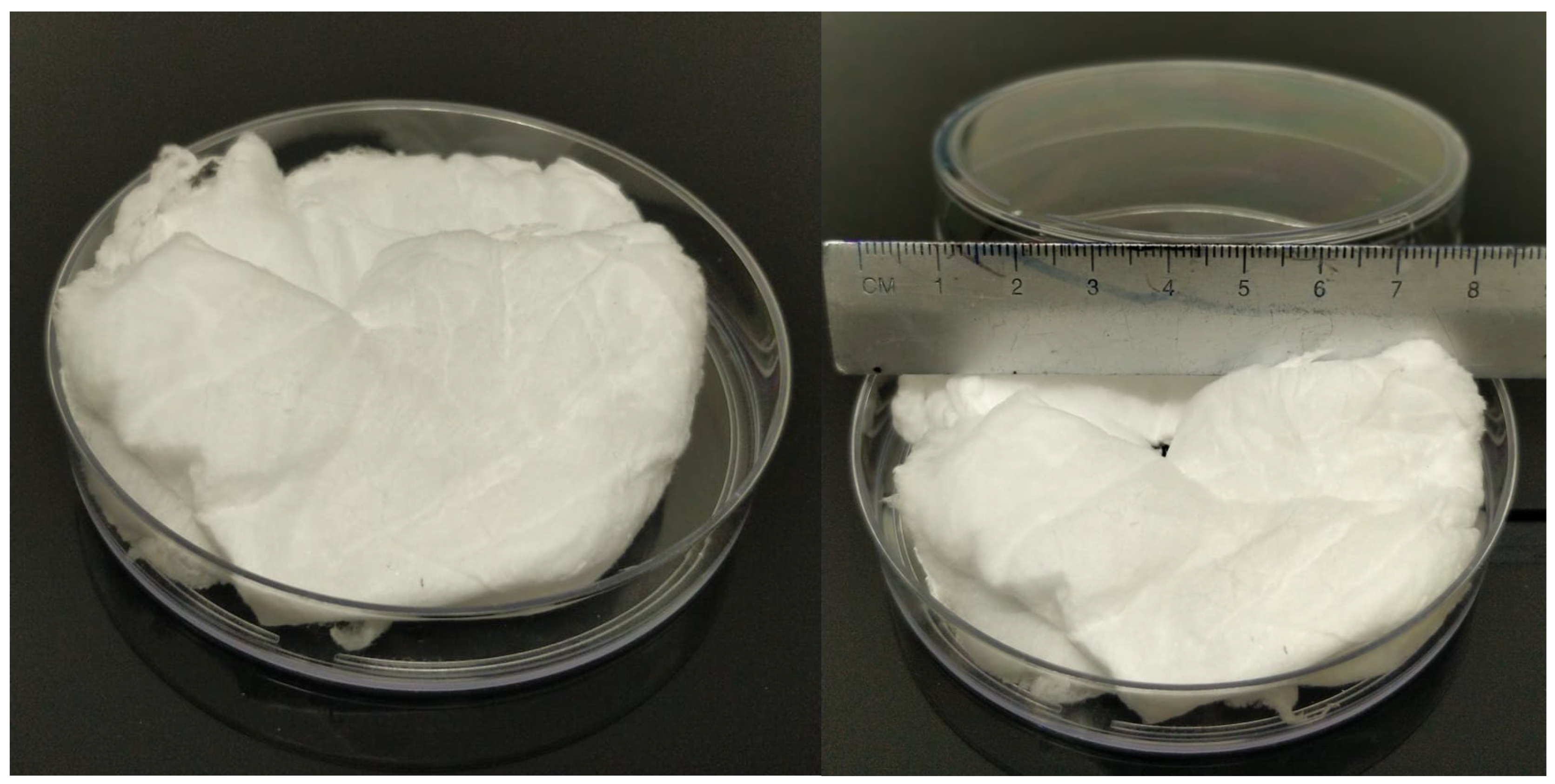
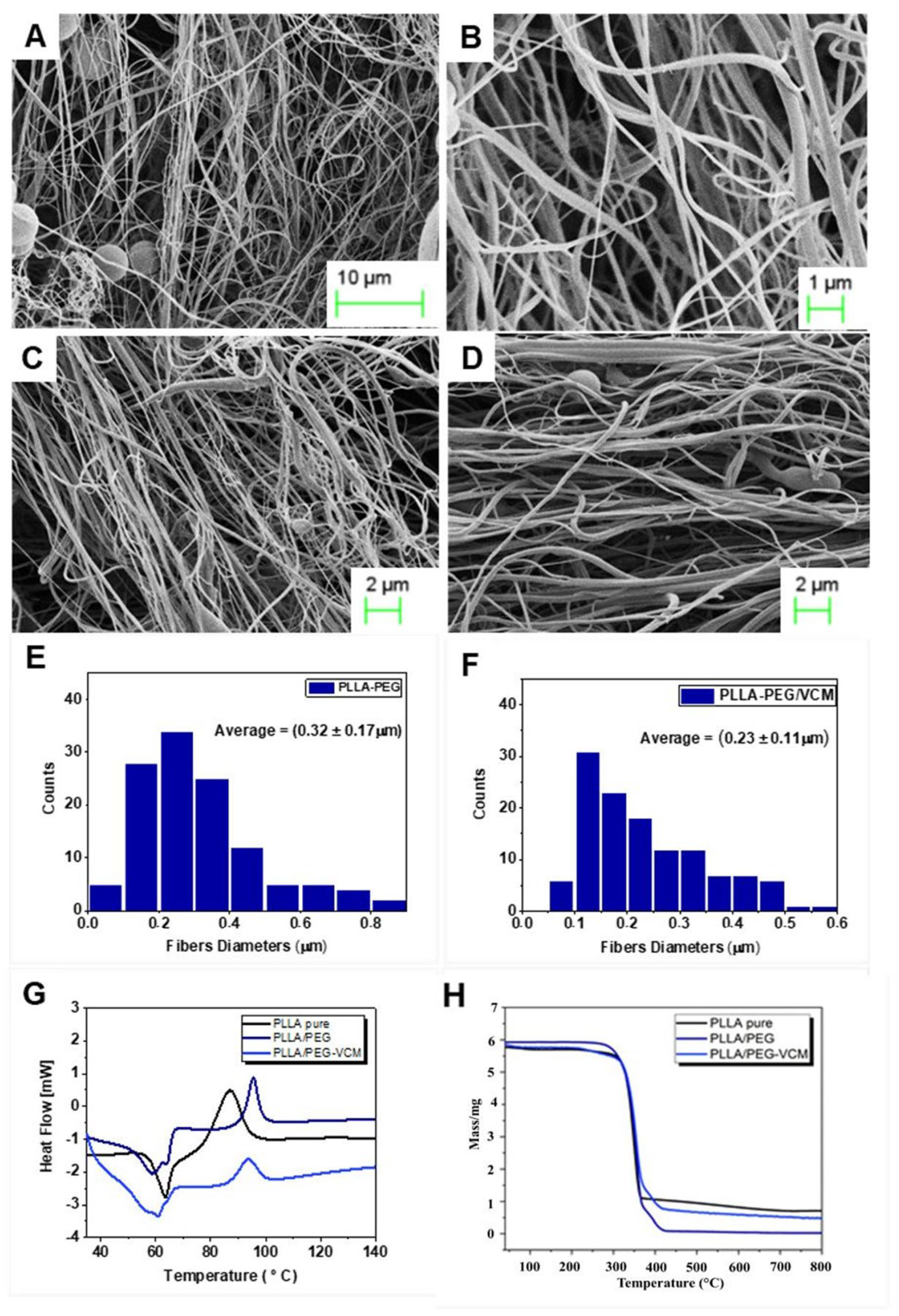
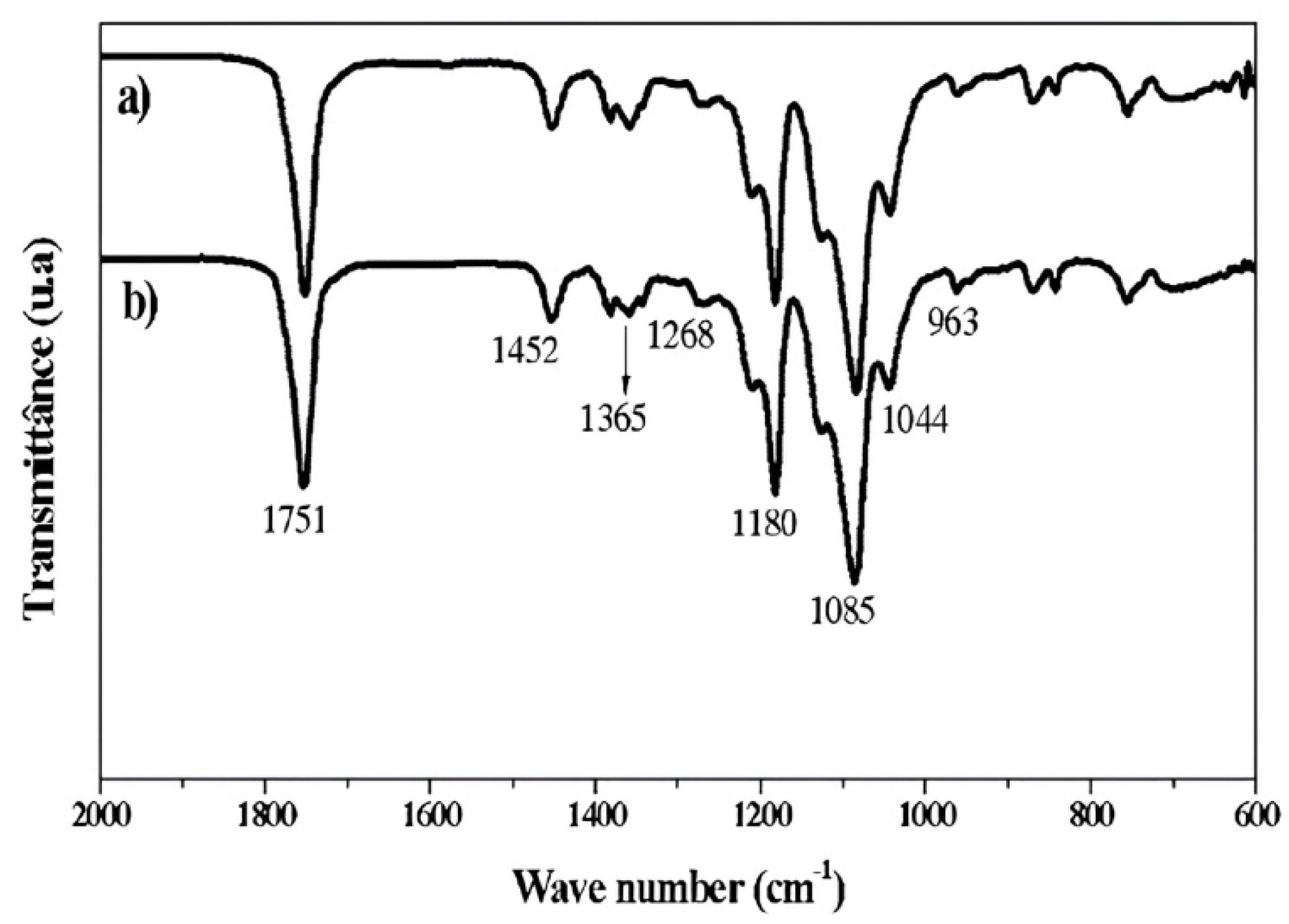
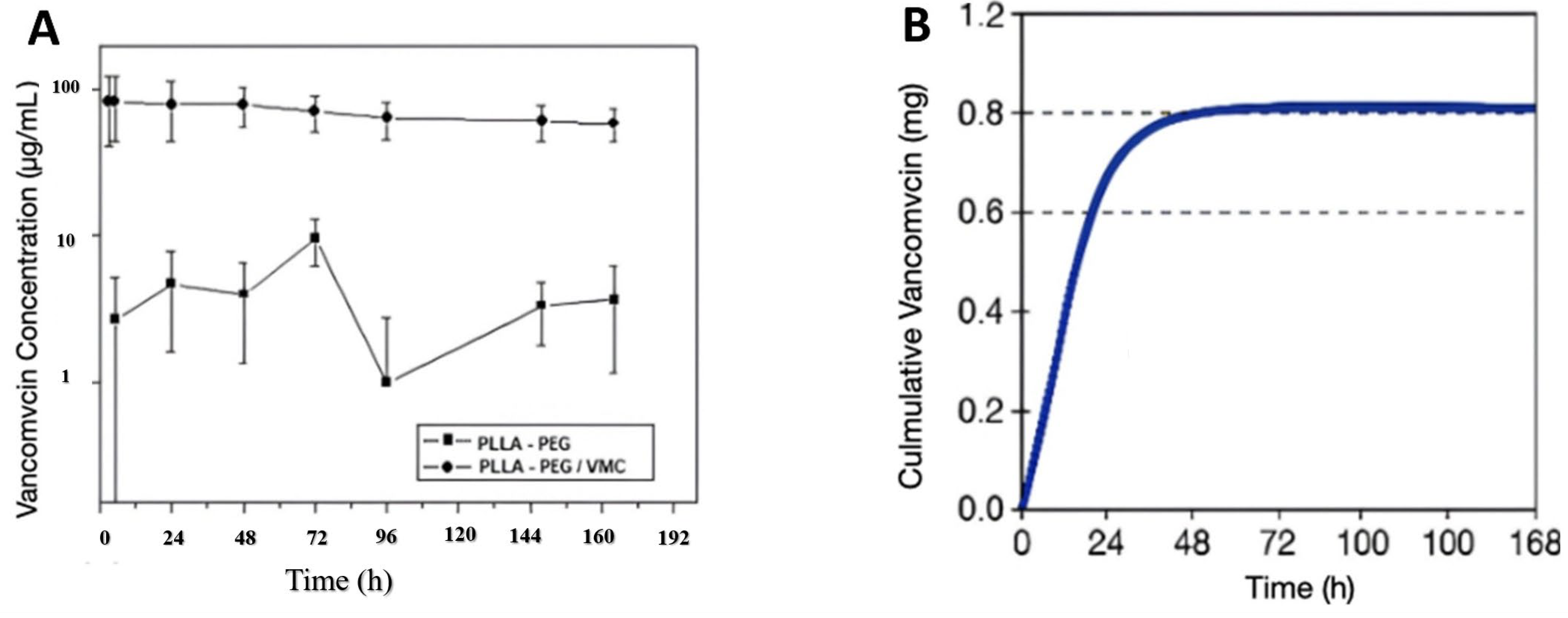
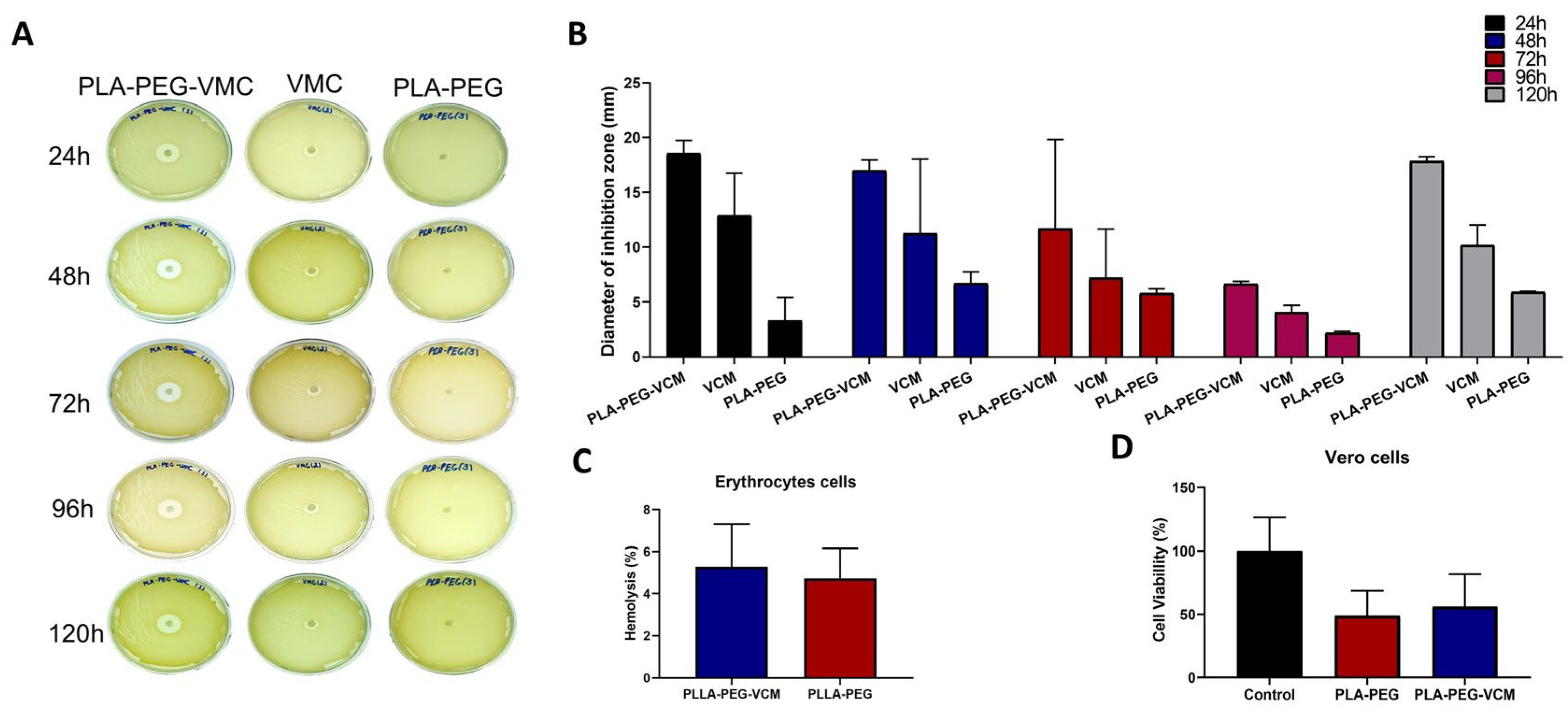
Disclaimer/Publisher’s Note: The statements, opinions and data contained in all publications are solely those of the individual author(s) and contributor(s) and not of MDPI and/or the editor(s). MDPI and/or the editor(s) disclaim responsibility for any injury to people or property resulting from any ideas, methods, instructions or products referred to in the content. |
© 2025 by the authors. Licensee MDPI, Basel, Switzerland. This article is an open access article distributed under the terms and conditions of the Creative Commons Attribution (CC BY) license (https://creativecommons.org/licenses/by/4.0/).
Share and Cite
Nascimento, T.R.d.L.; Guérin, A.L.; Rodrigues, M.S.; da Silva, C.F.; Maciel, B.M.; Alhotan, A.; Alhijji, S.; Velo, M.M.A.C.; Castellano, L.R.C. 3D Nanofibrous Scaffolds for Encapsulation-Controlled Vancomycin Delivery: Antibacterial Performance and Cytocompatibility. Polymers 2025, 17, 3116. https://doi.org/10.3390/polym17233116
Nascimento TRdL, Guérin AL, Rodrigues MS, da Silva CF, Maciel BM, Alhotan A, Alhijji S, Velo MMAC, Castellano LRC. 3D Nanofibrous Scaffolds for Encapsulation-Controlled Vancomycin Delivery: Antibacterial Performance and Cytocompatibility. Polymers. 2025; 17(23):3116. https://doi.org/10.3390/polym17233116
Chicago/Turabian StyleNascimento, Tatiana Rita de Lima, Aline Lima Guérin, Mariana Souza Rodrigues, Camila Félix da Silva, Bruno Martins Maciel, Abdulaziz Alhotan, Saleh Alhijji, Marilia Mattar Amoêdo Campos Velo, and Lúcio Roberto Cançado Castellano. 2025. "3D Nanofibrous Scaffolds for Encapsulation-Controlled Vancomycin Delivery: Antibacterial Performance and Cytocompatibility" Polymers 17, no. 23: 3116. https://doi.org/10.3390/polym17233116
APA StyleNascimento, T. R. d. L., Guérin, A. L., Rodrigues, M. S., da Silva, C. F., Maciel, B. M., Alhotan, A., Alhijji, S., Velo, M. M. A. C., & Castellano, L. R. C. (2025). 3D Nanofibrous Scaffolds for Encapsulation-Controlled Vancomycin Delivery: Antibacterial Performance and Cytocompatibility. Polymers, 17(23), 3116. https://doi.org/10.3390/polym17233116





